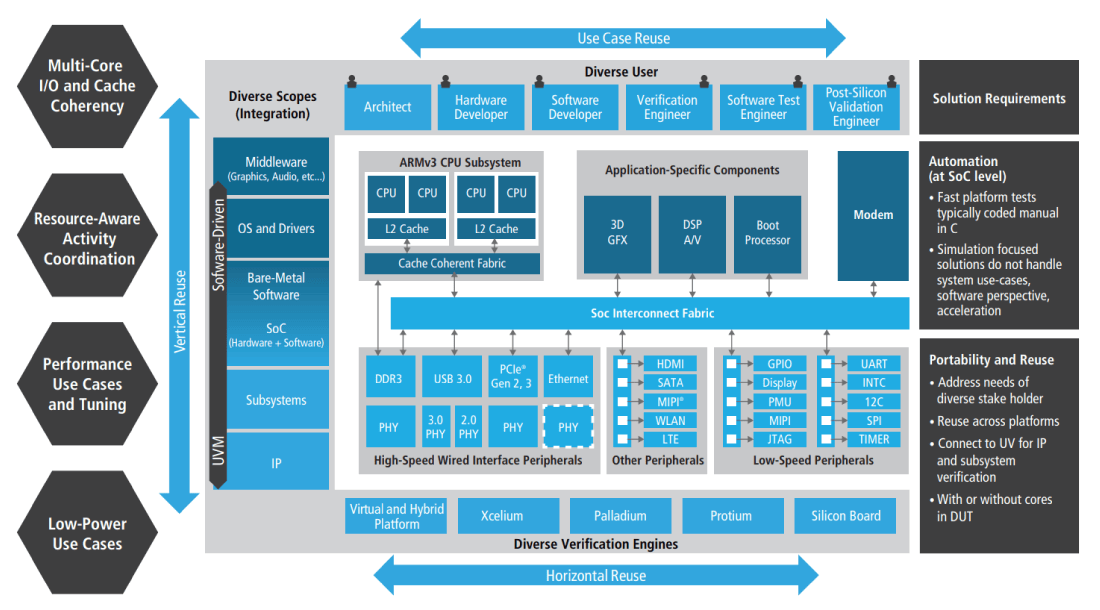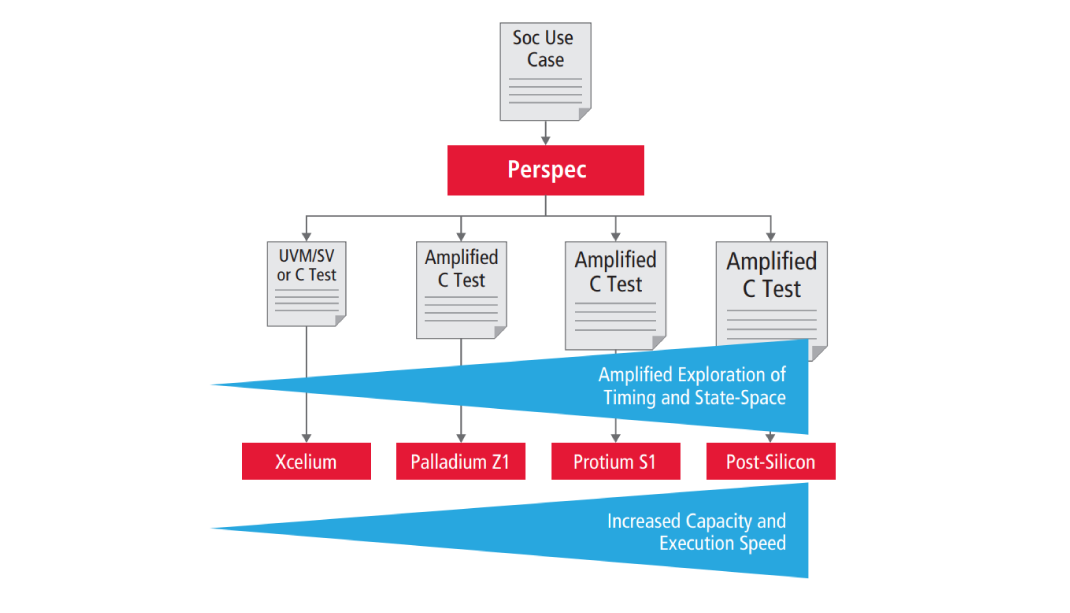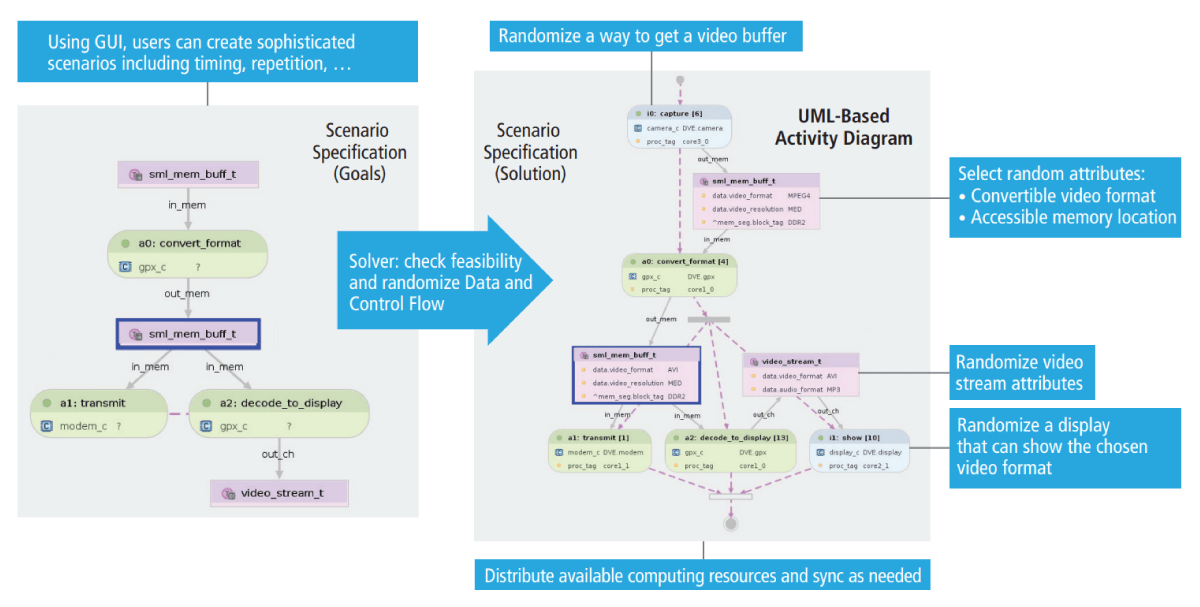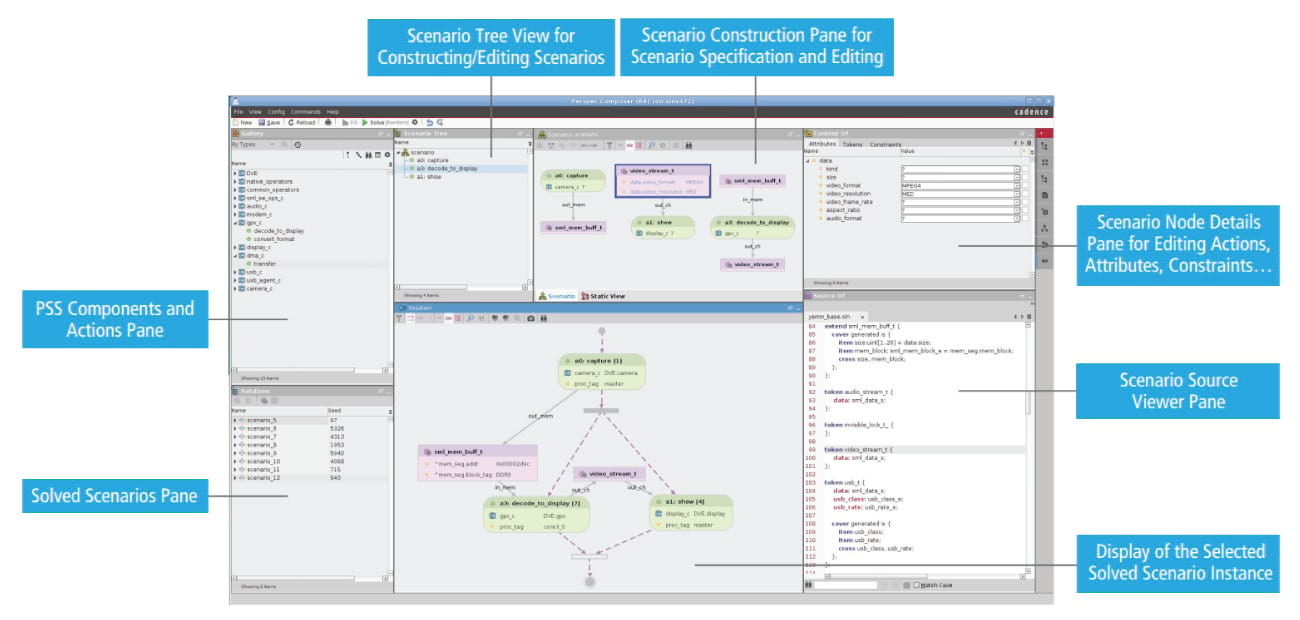Datasheet
Perspec System Verifier
SoC verification with portable stimulus
The Cadence Perspec System Verifier is a portable stimulus, system-on-chip (SoC) verification solution. The Perspec System Verifier improves SoC quality and saves time by reducing development effort for defining complex SoC-level use cases, amplifying use-case exploration of state space and timing on fast platforms, creating coverage-driven automation of system use-case generation, bridging UVM and SoC verification methodology, and shrinking the time required to reproduce, debug, and fix complex SoC-level bugs.
Overview
Requirements for SoC Verification
While the bottom-up approach offered by UVM-constrained random and coverage-driven verification revolutionized IP and unit-level testing, it doesn’t meet the requirements for SoC-level verification. To fully address SoC-level verification, a solution must extend from UVM and allow for vertical (IP to SoC) reuse and horizontal (verification engine portability) reuse. And most importantly it must provide a way to capture, share, and automcally amplify use cases to speed test-case creation and leverage fast verification engines.
The Perspec System Verifier addresses these three key requirements highlighted in Figure 1. By offering an abstract model-based approach, the Perspec solution not only enables capture of use cases, but through abstraction makes reuse, sharing, and amplification of the use cases easy. In order to deliver real tests, a solver is required to automate the creation of concrete use cases either through randomization or if requested through coverage filling. These concrete use cases can be used to automatically generate C tests that can be run natively and at speed on any of the verification engines depicted in the figure.
Today, the verification of electronic systems (SoCs) and subsystems is generally achieved using C tests. These tests compliment the IP-level verification performed with UVM. There are several reasons for the use of C tests, including:
C tests are typically created manually or by basic code generators, and lag far behind the UVM automation that has become mainstream for hardware functional verification. The effort of test creation and maintenance, test reuse that spans subsystems and systems, and leveraging these tests for future system derivatives, are not addressed properly by manually creating C tests.
Furthermore, the overall flow—defining goals, automating stimuli creation, launching tests to meet the goals, and collecting the results into a concise and intuitive dashboard—are challenges for productive system validation.
Product Overview
The Perspec System Verifier is a modelbased, goal-directed SoC verification product developed to meet these challenges. The Perspec usage flow includes the following steps:
- Capture the SoC actions needed to create a desired use case, if not already captured
- Compose the desired use case
- Use the Perspec System Verifier to solve the abstract use case to create concrete use cases or scenarios
- The Perspec solution generates C tests for the concrete scenario mapped to specific execution platform
- Run the tests on the targeted platform
- Debug the test and review coverage results
The Perspec solution supports the capture of abstract models of system actions and resources by using System-Level Notation (SLN) (Step 1). The abstract models are visualized using Unified Modeling Language (UML)-based graphical notation to simplify creation, modification, and use of complex use cases or scenarios (Step 2).
The Perspec solution includes a constraint solver that generates concrete scenarios from user-directed, random-selection, or coverage-driven fills of both data and control flow from the abstract scenario and can show both legal and illegal concrete scenarios based upon the rules defined in the models (Step 3).
In addition, the coverage for the scenario is calculated when generated (gen-time coverage) and can be compared with actual execution results once tests are run (runtime coverage). In Figure 3, the abstract scenario is shown on the left and a concrete solution, a UML activity diagram, is shown on the right. The solver fills in everything needed to create an executable scenario. The callouts identify some of the choices made by the solver.
From a concrete scenario, the Perspec solution automates the generation of a C test that fulfills the scenario, including the inter-processor communication and multi-task scheduling required (Step 4). The C tests can run natively at speed on the Xcelium, Palladium Z1, Protium S1, and even post-silicon boards, and can also be automatically amplified to take full advantage of the faster platforms (Step 5). The C tests can also be generated to connect to an existing UVM environment for constrained random verification of IP and interface scenarios using the Xcelium simulator.
When the test runs, it generates a log that can be used to debug the test with Cadence’s Indago Debug Analyzer and coverage results can be analyzed in the context of the verification plan using the vManager Metric-Driven Signoff Platform (Step 6).
Connecting It Together
As shown above, the combination of abstract system actions with a constrained random solver that can randomize both control and data offers significant productivity improvement over manual creation of tests, but the real value is the ability to capture complex SoC-level use cases that would otherwise go unverified and to find bugs in the implementation that would go undetected until the problem occurs in actual use.
To illustrate, let’s consider how to verify a use case where multiple cache coherent processors are operating on different tasks and where you need to verify that the cache coherency is maintained even when powering some of the processors on and off. Most customers today avoid tackling the development of a directed test for this type of complex use case because of the level of expertise required in both coherency and power management and the complexity of the software required to create this use case. Instead, they rely on their production software to validate these types of complex use cases as best they can. With the Perspec solution, it is easy to take advantage of use cases developed by domain experts and to create new, more complex SoC use cases by mixing use cases.
Figure 4 highlights how the Perspec solution not only makes it possible to create the complex use case of mixing power shutdown and coherency, but as depicted allows other users to take advantage of use cases created by domain experts without needing to become a domain expert. In addition, the Perspec solution automates the generation of the complex C tests for any target platform.
Features
Verification Engines
Out-of-the-box test generation and execution support for using Cadence verification engines:
VIP
The Cadence Verification IP (VIP) Catalog can be used for UVM simulation of IP interface protocols, as well as accelerated VIP for SoC verification and system emulation. Many VIP for UVM are available with C cores for fast execution and portability, and come with the TripleCheck tool, which includes an extensive library of test sequences, a coverage model for tracking and measuring verification progress, and a verification plan that mirrors the protocol specification.
The Perspec solution can generate tests that drive UVM simulation tests in the VIP for coverage driven verification. The Perspec solution can also use the same portable stimulus to generate tests for acceleration with accelerated Verification IP.




